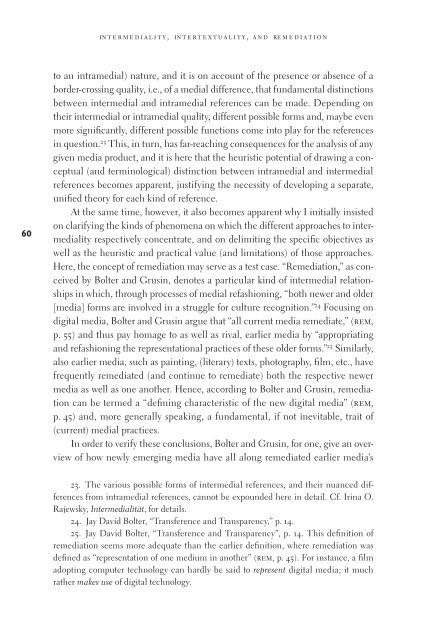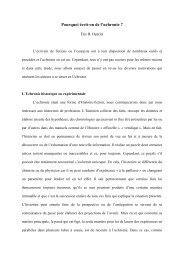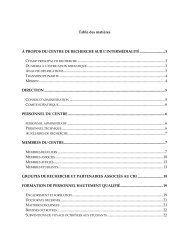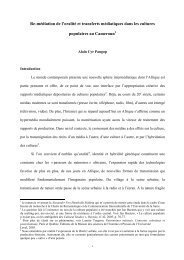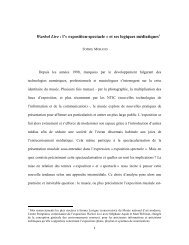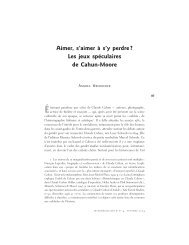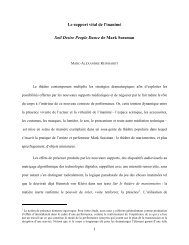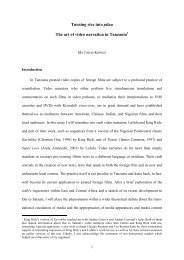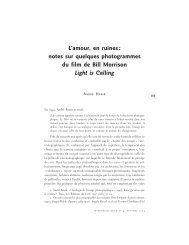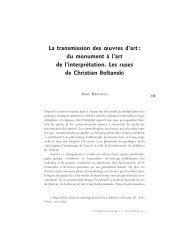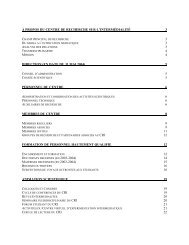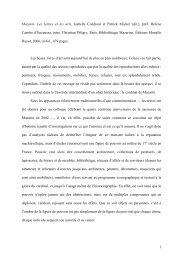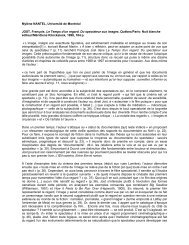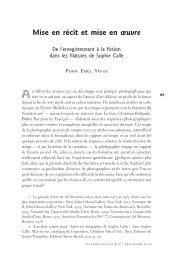Intermediality - Centre de recherche sur l'intermédialité (CRI ...
Intermediality - Centre de recherche sur l'intermédialité (CRI ...
Intermediality - Centre de recherche sur l'intermédialité (CRI ...
Create successful ePaper yourself
Turn your PDF publications into a flip-book with our unique Google optimized e-Paper software.
60<br />
intermediality, intertextuality, and remediation<br />
to an intramedial) nature, and it is on account of the presence or absence of a<br />
bor<strong>de</strong>r-crossing quality, i.e., of a medial difference, that fundamental distinctions<br />
between intermedial and intramedial references can be ma<strong>de</strong>. Depending on<br />
their intermedial or intramedial quality, different possible forms and, maybe even<br />
more signifi cantly, different possible functions come into play for the references<br />
in question. 23 This, in turn, has far-reaching consequences for the analysis of any<br />
given media product, and it is here that the heuristic potential of drawing a conceptual<br />
(and terminological) distinction between intramedial and intermedial<br />
references becomes apparent, justifying the necessity of <strong>de</strong>veloping a separate,<br />
unifi ed theory for each kind of reference.<br />
At the same time, however, it also becomes apparent why I initially insisted<br />
on clarifying the kinds of phenomena on which the different approaches to intermediality<br />
respectively concentrate, and on <strong>de</strong>limiting the specifi c objectives as<br />
well as the heuristic and practical value (and limitations) of those approaches.<br />
Here, the concept of remediation may serve as a test case. “Remediation,” as conceived<br />
by Bolter and Grusin, <strong>de</strong>notes a particular kind of intermedial relationships<br />
in which, through processes of medial refashioning, “both newer and ol<strong>de</strong>r<br />
[media] forms are involved in a struggle for culture recognition.” 24 Focusing on<br />
digital media, Bolter and Grusin argue that “all current media remediate,” (rem,<br />
p. 55) and thus pay homage to as well as rival, earlier media by “appropriating<br />
and refashioning the representational practices of these ol<strong>de</strong>r forms.” 25 Similarly,<br />
also earlier media, such as painting, (literary) texts, photography, fi lm, etc., have<br />
frequently remediated (and continue to remediate) both the respective newer<br />
media as well as one another. Hence, according to Bolter and Grusin, remediation<br />
can be termed a “<strong>de</strong>fi ning characteristic of the new digital media” (rem,<br />
p. 45) and, more generally speaking, a fundamental, if not inevitable, trait of<br />
(current) medial practices.<br />
In or<strong>de</strong>r to verify these conclusions, Bolter and Grusin, for one, give an overview<br />
of how newly emerging media have all along remediated earlier media’s<br />
23. The various possible forms of intermedial references, and their nuanced differences<br />
from intramedial references, cannot be expoun<strong>de</strong>d here in <strong>de</strong>tail. Cf. Irina O.<br />
Rajewsky, Intermedialität, for <strong>de</strong>tails.<br />
24. Jay David Bolter, “Transference and Transparency,” p. 14.<br />
25. Jay David Bolter, “Transference and Transparency”, p. 14. This <strong>de</strong>fi nition of<br />
remediation seems more a<strong>de</strong>quate than the earlier <strong>de</strong>fi nition, where remediation was<br />
<strong>de</strong>fi ned as “representation of one medium in another” (rem, p. 45). For instance, a fi lm<br />
adopting computer technology can hardly be said to represent digital media; it much<br />
rather makes use of digital technology.


